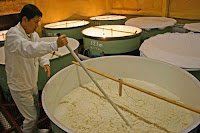 Today began with traditional Japanese breakfast prepared by Mrs. Sakurai. Although I was still somewhat full from the Fugu (and most certainly 6-meal Sunday), it was the perfect way to start what turns out to be a very busy day. The morning will be onsite tour of saké production, followed by afternoon visit to Hiroshima to accomodate Sakurai-san's early morning flight on Wednesday. Part I will be a photo essay of Asahi Shuzo. (Click on pics to enlarge.)
Today began with traditional Japanese breakfast prepared by Mrs. Sakurai. Although I was still somewhat full from the Fugu (and most certainly 6-meal Sunday), it was the perfect way to start what turns out to be a very busy day. The morning will be onsite tour of saké production, followed by afternoon visit to Hiroshima to accomodate Sakurai-san's early morning flight on Wednesday. Part I will be a photo essay of Asahi Shuzo. (Click on pics to enlarge.) The old sign welcomes the visitors by the entrance.
The old sign welcomes the visitors by the entrance.
This is the machine used for washing rice prior to steaming.
 Unoading rice into the steamer.
Unoading rice into the steamer.
 Steaming in action.
Steaming in action.  After the rice is steamed, it is sent through this conveyer.
After the rice is steamed, it is sent through this conveyer.
 If the rice is used for koji making, it is sent up as is straight into the Koji room where Mr. Yanai and Mr. Hirotsu carefully develop Koji Rice. Here, rice is spread out prior to adding Koji yeast.
If the rice is used for koji making, it is sent up as is straight into the Koji room where Mr. Yanai and Mr. Hirotsu carefully develop Koji Rice. Here, rice is spread out prior to adding Koji yeast.
Sprinkling Koji Yeast. As you can see through the lens, it is humid and hot (38-40C/100-104F) in there.
Breaking up Koji Rice clusters.
 If the rice is used for making the mash, it is cooled by the conveyer before being sent straight into one of these tanks.
If the rice is used for making the mash, it is cooled by the conveyer before being sent straight into one of these tanks.
Looking inside one of the tanks (capacity: 4,463L)
 At ASahi Shuzo, condition of each tank is meticulously recorded in order to produce consistency.
At ASahi Shuzo, condition of each tank is meticulously recorded in order to produce consistency.
 Here is the Yabuta pressing machine. There are 77 panels in this one.
Here is the Yabuta pressing machine. There are 77 panels in this one.
 This is the Tōshin (遠心), also known as “Centrifuge.” Note its size compared to Sakurai-san.
This is the Tōshin (遠心), also known as “Centrifuge.” Note its size compared to Sakurai-san.
 Here are test bottles. These are fresh nama and unfiltered, straight from the tank.
Here are test bottles. These are fresh nama and unfiltered, straight from the tank.
(Lot number, polishing ratio, and pressing methods are noted.)
Some Notes about Dassai:
* They are meticulous and systematic in their production so that young staff can make very good sakés consistently.
* Incidentally, I believe the youngest staff is Mr. Hirotsu in Koji Room at 23 years old, and Toji (Nishida-san) is 36 years old.
* They were bottling about 2,000 bottles on this day.
 A BIG thank you to Sakurai Family for their generous hospitality!
A BIG thank you to Sakurai Family for their generous hospitality!








No comments:
Post a Comment